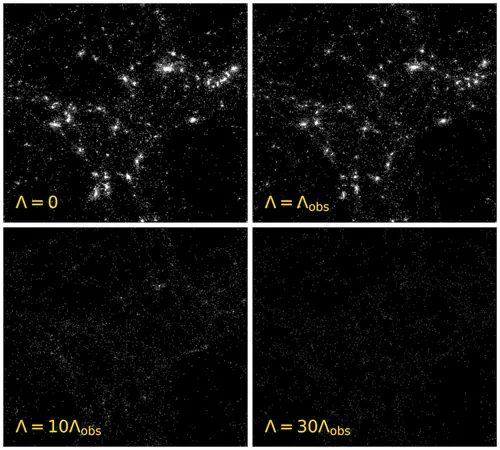
Unraveling the Mysteries of the Cosmos: New Model Predicts the Probability of Intelligent Life
2024-11-13
Author: Yan
Unraveling the Mysteries of the Cosmos: New Model Predicts the Probability of Intelligent Life
In a groundbreaking study reminiscent of the famous Drake Equation, researchers from Durham University have introduced a novel theoretical model aimed at estimating the likelihood of intelligent life emerging in our universe and potentially in others beyond our wildest imagination.
Originally proposed by American astronomer Dr. Frank Drake in the 1960s, the Drake Equation sought to quantify the number of extraterrestrial civilizations we might detect in our Milky Way galaxy. Fast forward over six decades, and the scientific community has produced a fresh approach that focuses on two critical factors: the conditions resulting from the universe’s accelerating expansion and the rate at which stars are formed.
What Drives the Universe's Expansion?
The accelerating expansion of the universe is believed to be fueled by dark energy, a mysterious and poorly understood force that constitutes more than 66% of the cosmos. This newfound model presents a fascinating calculation, contending that because stars are fundamental to the development of life as we know it, understanding how stars form in varying conditions could shed light on the odds of intelligent life emerging.
Insights from the New Research
Published in the esteemed Monthly Notices of the Royal Astronomical Society, the study does not attempt to calculate the absolute number of intelligent beings in the universe. Instead, it evaluates the relative probability of randomly selected observers residing in universes with specific properties.
The findings reveal that a typical observer is likely to exist in an environment characterized by a greater density of dark energy than what is currently observed in our universe. This intriguing discovery suggests that the conditions present in our universe are rare, challenging previous assumptions about our cosmological setting.
Key to the model's predictions is the intriguing notion that approximately 27% of ordinary matter could be converted into stars in an optimal universe—compared to only 23% in our own universe. This revelation leads to a critical conclusion: we are not nestled in the universe with the highest chances of developing intelligent life, raising existential questions about our place in the cosmos.
The Role of Dark Energy
Dr. Daniele Sorini, the lead researcher from Durham's Institute for Computational Cosmology, emphasized the pivotal nature of dark energy in understanding our universe: "Grasping dark energy's ramifications is among the foremost challenges in cosmology and fundamental physics. The characteristics governing our universe, including dark energy density, might explain our very existence."
Surprisingly, the research indicates that a higher density of dark energy could still support life, suggesting that we may not inhabit the most favorable universe for nurturing intelligent beings. This model paves the way for further exploration into how dark energy influences the formation of galaxies and the potential havens for life.
Implications for the Search for Life
It's crucial for the development of life that there are regions within the expanding universe where matter can clump together to form stable stars and planets—stable enough to support the evolution of life for billions of years. The researchers propose that the interplay between star formation astrophysics and the large-scale structure of the universe is key to determining the ideal dark energy density conducive to intelligent life.
With excitement, co-author Professor Lucas Lombriser from the Université de Genève remarked, "We are eager to use this model to investigate the potential for life to emerge in different universes, possibly inviting a re-evaluation of fundamental questions we have about our own universe."
The Drake Equation Revisited
Dr. Drake’s original equation acted more as a framework for scientists venturing into the search for extraterrestrial intelligence rather than a specific predictive tool. Its elements included the annual rate of star formation in our galaxy, the fraction of those stars that are planets, and the number of suitable worlds for life.
In contrast, the new model intricately links the rate of star formation with critical cosmic constituents, such as dark energy density—paving the path for a more nuanced understanding of life in the cosmos.
This revolutionary research, attracting collaboration from experts at the University of Edinburgh and Université de Genève, is not just a step forward in cosmology; it invites us to ponder our own existence and whether the universe we call home is truly as unique as we think. As the quest for knowledge continues, one can’t help but wonder: Are we alone in a universe rich with possibilities?




 Brasil (PT)
Brasil (PT)
 Canada (EN)
Canada (EN)
 Chile (ES)
Chile (ES)
 España (ES)
España (ES)
 France (FR)
France (FR)
 Hong Kong (EN)
Hong Kong (EN)
 Italia (IT)
Italia (IT)
 日本 (JA)
日本 (JA)
 Magyarország (HU)
Magyarország (HU)
 Norge (NO)
Norge (NO)
 Polska (PL)
Polska (PL)
 Schweiz (DE)
Schweiz (DE)
 Singapore (EN)
Singapore (EN)
 Sverige (SV)
Sverige (SV)
 Suomi (FI)
Suomi (FI)
 Türkiye (TR)
Türkiye (TR)